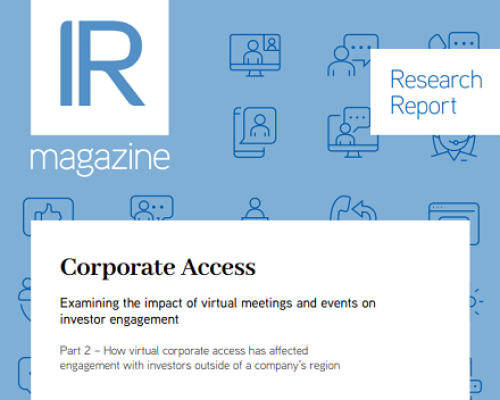Communicating a company’s equity story to the investment community lies at the heart of effective IR, but it can be a tricky task to get right in terms of both messaging and tactics. We hear from Joanna Copestake, director at JLC Investor Relations and a former fund manager, who shares her views and top tips on how IROs can talk to investors more effectively.
In your experience, which communication methods are best received by investors?
Investors like and appreciate simple, clear and consistent communication, whether through written results statements, presentations or one-on-one meetings. The term ‘under-promise and over-deliver’ may seem old-school but it is one that still chimes very closely with investors in their search for attractive investment propositions.
Many investors favor the ‘less is more’ approach in terms of frequency of contact with the equity markets to reduce the noise and share price volatility around short-term trading dynamics. It is important to bear in mind, however, that issuing fewer trading updates may increase the chance of surprising the market given the length of time between releases. We all know markets don’t like surprises, so providing conservative, realistic guidance and achieving the optimal balance in frequency of communication is a very important part of the approach.
What importance do you place on ‘soft skills’ when communicating to investors, and why?
In the post-Mifid II world where many companies have less sell-side coverage and potentially reduced interaction with the buy side, soft skills are increasingly important. Investors will need more hand-holding when it comes to understanding the equity story for your company. A call or email to your top shareholders following results has always been a good way to strengthen your individual relationships and ensure your investors fully understand the key messages you want to convey.
A simple but effective ‘soft skill’ communication tool is to occasionally ask your investors where their concerns lie. The benefit of this is two-fold: they feel you are listening to them, and you gain a better understanding of their view of the company.
What are the ‘story basics’ IROs need to convey to investors above all else?
Investors need to understand what the investment case is for your company and be able to place it in their investing style framework – they need to know what they’re buying into and ensure it will meet their fund’s criteria. By this, I mean clearly articulating the strategic and financial profile of your company.
For example, is it a revenue growth story, a profit and margin story, a turnaround restructuring story or a long-term strategic play on industry growth and consolidation? If the dividend is an important part of the capital allocation framework of the company, this should feature as an example of consistent and reliable cash income to shareholders. If the balance sheet is a key strength of the business, you need to provide a clear capital allocation framework, so investors understand how you may use your financial flexibility.
What are the key communication skills IROs need to hone to maximize their effectiveness?
The most successful and effective IROs in my view are those whom investors and analysts trust to tell a simple, honest and consistent story. An IRO cannot determine the direction or fortune of his or her company. Therefore, it is essential to build a strong enough reputation that can carry investor relationships through bad times as well as good.
How can IROs combine soft skills with today’s modern technology? Can the two work together?
Embracing technology as part of your investor communication is important if you want to reach different investors – some may still expect traditional forms of communication, but others may be far more advanced in their processes to receive and assess information from companies. In the post-Mifid II environment, technology platforms that present opportunities to connect and engage with potential investors (a service that corporate brokers and banks may no longer offer) could be an effective way to maintain and grow your investor network.
What is your overall top tip for IROs seeking to improve their investor communications?
Build your reputation and strengthen your relationship with individual investors as well as the broader market. Conducting an investor perception review can help raise the profile of your company as well as provide you with deeper understanding of how individual investors perceive your equity story. Think about how to simplify your key messages and your strategy, and how to provide realistic and achievable guidance. Above all, always maintain an ‘under-promise and over-deliver’ approach to communication to build trust in the market.










